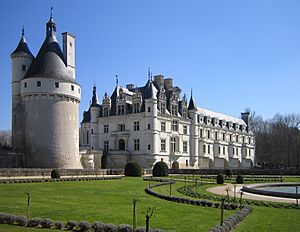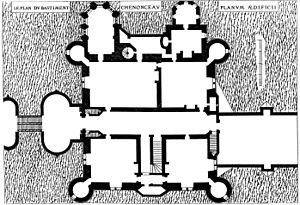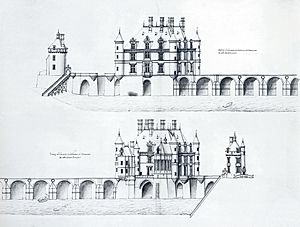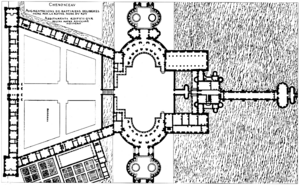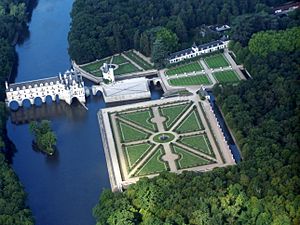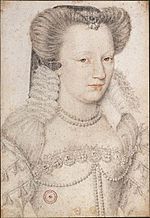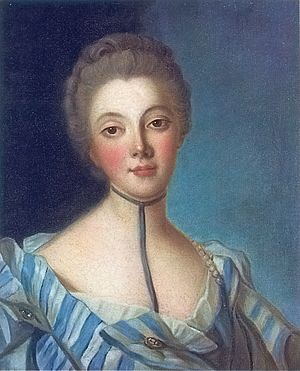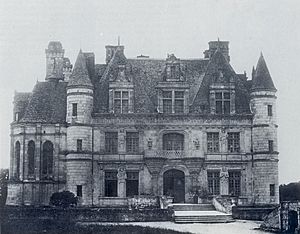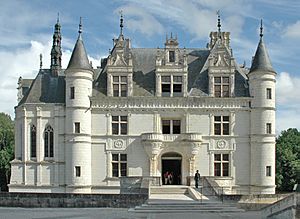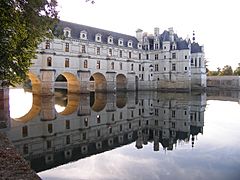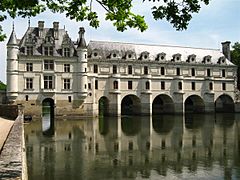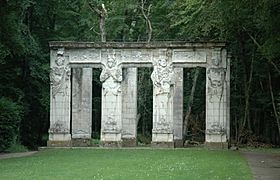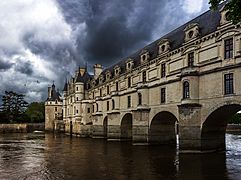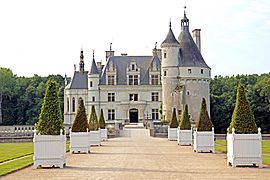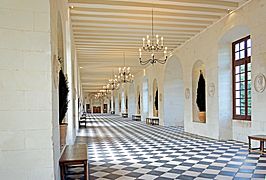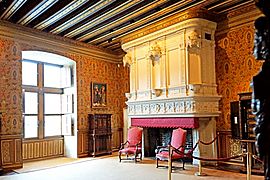Château de Chenonceau facts for kids
Quick facts for kids Château de Chenonceau |
|
|---|---|
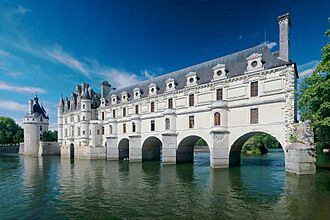
The Château de Chenonceau, on the river Cher
|
|
| General information | |
| Location | Chenonceaux, Indre-et-Loire, France |
| Coordinates | 47°19′29″N 1°04′13″E / 47.3247°N 1.0704°E |
The Château de Chenonceau (pronounced shah-TOH duh shuh-nohn-SOH) is a beautiful French castle. It stretches right over the Cher River, near a small village called Chenonceaux in France. It is one of the most famous castles in the Loire Valley, a region known for its many grand châteaux.
The first mention of the Chenonceau estate was in the 11th century. The castle you see today was built between 1514 and 1522. It was constructed on the foundations of an old mill. Later, a bridge was added across the river from 1556 to 1559, designed by the architect Philibert de l'Orme. A long gallery, or hallway, was then built on top of this bridge between 1570 and 1576, designed by Jean Bullant.
What Makes Chenonceau Special?
The Château de Chenonceau has a mix of old Gothic and early Renaissance styles. Both the castle and its lovely gardens are open for visitors. After the Royal Palace of Versailles, Chenonceau is the most visited castle in France.
The French Ministry of Culture officially recognized the château as a Monument historique (a historical monument) in 1840. This means it is a very important part of France's history and heritage. In 2007, about 800,000 people visited Chenonceau, showing how popular it is!
A Look at Chenonceau's History
The Marques Family and Early Days
In the 1200s, the land of Chenonceau belonged to the Marques family. The first castle on this spot was burned down in 1412. This happened because its owner, Jean Marques, had rebelled against the king. He rebuilt a new castle and a strong mill in the 1430s. However, Jean Marques' son, Pierre Marques, owed a lot of money and had to sell the property.
Thomas Bohier's New Castle
In 1513, Thomas Bohier, who worked for King Charles VIII of France, bought the castle from Pierre Marques. Bohier tore down most of the old castle, but he kept its 15th-century tower. He then built a completely new home between 1515 and 1521. His wife, Katherine Briçonnet, was in charge of the building work. She loved to host important French nobles, including King Francis I of France more than once.
Diane de Poitiers and Her Gardens
In 1535, King Francis I of France took the château from Bohier's son because of unpaid debts. After King Francis died in 1547, his son, Henry II of France, gave the château as a gift to his close friend, Diane de Poitiers. Diane loved the castle by the river very much.
In 1555, she asked Philibert de l'Orme to design an arched bridge connecting the castle to the other side of the river. Diane then created beautiful flower and vegetable gardens, along with many fruit trees. These amazing gardens were shaped like four triangles and were protected from floods by stone walls. Diane was the true lady of the castle, but she only officially owned it after many years of legal work in 1555.
Catherine de' Medici's Grand Additions
After King Henry II died in 1559, his powerful wife, Catherine de' Medici, made Diane trade Chenonceau for another castle, the Château Chaumont. Queen Catherine then made Chenonceau her favorite home. She added even more gardens to the estate.
As the person in charge of France (called a Regent), Catherine spent a lot of money on the château. She hosted amazing nighttime parties there. In 1560, the first fireworks display ever seen in France happened at Chenonceau. This was part of the celebrations when Catherine's son, Francis II of France, became king.
The grand long gallery, which stretched across the entire river on the existing bridge, was finished in 1577. Catherine also added rooms between the chapel and the library on the east side of the main building. She also added a service area on the west side of the entrance courtyard.
Catherine even thought about making the château much bigger. A drawing from 1579 shows her plan. If this huge project had been built, the current castle would have been just a small part of a giant estate.
Louise de Lorraine's Sad Time
When Catherine died in January 1589, the château went to her daughter-in-law, Louise of Lorraine. Louise was the wife of King Henry III of France. Louise was at Chenonceau when she heard that her husband had been killed in August 1589. She became very sad and depressed. For the next 11 years, until she died in January 1601, Louise wandered through the castle's hallways. She always wore black mourning clothes, and the castle was decorated with dark tapestries showing skulls and crossbones.
The Duke of Vendôme and Later Owners
Henri IV of France got Chenonceau for his friend, Gabrielle d'Estrées. He did this by paying off Catherine de' Medici's debts, which Louise had inherited. In return, Louise left the château to her young niece, Françoise de Lorraine. Françoise was engaged to César, Duke of Vendôme, who was the son of Gabrielle d'Estrées and Henry IV.
The château belonged to the Duke of Vendôme and his family for over a hundred years. The House of Bourbon kings were not very interested in the castle, except for hunting. In 1650, Louis XIV was the last king to visit Chenonceau before the French Revolution.
In 1720, the Duke of Bourbon bought the Château de Chenonceau. He slowly sold off all the valuable items inside the castle. Many of the beautiful statues ended up at the Palace of Versailles.
Louise Dupin and the Enlightenment
In 1733, a wealthy man named Claude Dupin bought the estate. His wife, Louise Dupin, was a very smart, beautiful, and educated woman. She loved the arts and theater. Louise Dupin held famous gatherings at Chenonceau, where important thinkers of the Age of Enlightenment would meet. Writers like Voltaire and Montesquieu visited, along with scientists and philosophers. Jean-Jacques Rousseau even worked as Dupin's secretary and taught her son. Rousseau wrote some of his famous works while at Chenonceau.
Louise Dupin saved the château from being destroyed during the French Revolution. She convinced the revolutionaries that the castle was important for travel and trade. It was the only bridge across the river for many miles, so they decided not to tear it down.
Marguerite Pelouze's Restoration
In 1864, a rich heiress named Marguerite Pelouze bought the château. Around 1875, she hired an architect named Félix Roguet to restore it. He almost completely redid the inside of the castle. He also removed some of Catherine de' Medici's additions, including rooms and statues on the north side. These statues were moved to the park. Marguerite spent so much money on these projects and on fancy parties that she ran out of funds. The château was then taken and sold.
Recent History of Chenonceau
In 1891, a millionaire from Cuba, José-Emilio Terry, bought Chenonceau from Madame Pelouze. Terry sold it to a family member, Francisco Terry, in 1896. Then, in 1913, the château was bought by Henri Menier, whose family is famous for their chocolates. The Menier family still owns the castle today.
During World War I, Gaston Menier turned the long gallery into a hospital ward for injured soldiers. During World War II, the château was bombed by German forces in June 1940. It also became a secret way for people to escape from the German-occupied side of the Cher River to the "free" zone on the other bank. The château was bombed again by the Allies of World War II on June 7, 1944, and the chapel was hit, destroying its windows.
In 1951, the Menier family asked Bernard Voisin to restore the château. He brought the castle and its gardens, which had been damaged by a flood in 1940, back to their former beauty.
Gallery
-
Francis I's Drawing Room
See also
 In Spanish: Castillo de Chenonceau para niños
In Spanish: Castillo de Chenonceau para niños
- List of castles in France
- Château de Montsoreau, another castle built in the Loire riverbed


